Nibiru-Planet X & Zecharia Sitchin
Abstract: An Essay Evaluating the theory of Nibiru as presented by Zecharia Sitchin from his study of ancient Sumerian/Babylonian cuneiform Tablets. The main areas covered include:
2) The viability of its orbit as proposed by Sitchin.
3) Modern astronomical research to detect Planet X.
Planet X Research To the Present
Officially, within the astronomical community, the hunt for Planet X has been on since just after the discovery of Neptune in 1846, following confirmation that its orbit was found to possess unusual perturbations, the result of what was thought to be another undiscovered object still further out, acting upon it. The very term Planet X, was thus simply given to denote the next orbital body of significance, that remained to be discovered in light of such perturbations. Now with the later discovery of Pluto in 1930, it was initially thought that the celestial body responsible for Neptune's observed perturbations had indeed been found.
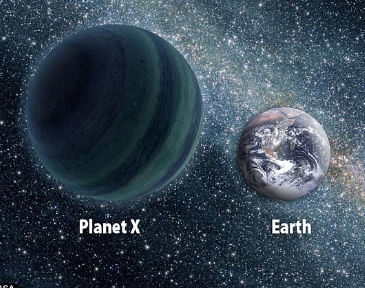
However, following the detection of a moon orbiting Pluto in 1978, given the name Charon, it was then possible to determine the mass of Pluto, which was found to be quite insufficient to account for Neptune's orbital anomalies. With what seemed then to be almost a lull period in the research, the hunt for Planet X was back on, so to speak.
Now it would be well to acknowledge here that astrophysicists of the recent period, still working towards the discovery, have so far only been able to put forward solutions for the most likely orbit of Planet X, including its mass, based solely upon the evaluation of anomalous movements of known celestial bodies. Specifically, Uranus, Neptune, and various comets.
And also, certain Kuiper belt objects located beyond Neptune, which form the outer asteroid belt of our solar system. Indeed, to date no worldwide announcement has thus been made of the actual discovery of Planet X, providing complete information as to all its orbital elements, including even pictures. In the face of all the evidence for its existence, albeit indirect, the actual isolation of the body, remains.
That being said, from the studies so far conducted up to the present date, the evidence gathered by the astronomical community does indeed point towards a general solution for Planet X, that is not too radical in nature. An elliptical orbit, though not of extreme eccentricity; an orbital plane reasonably close to the ecliptic, and a mass value not too excessive for close proximity to the outer bodies of our solar system.
Enter Zecharia Sitchin

Now in the face of this however, it is most interesting to find that there are those that take great issue with this stated position as held by the orthodox astronomical community. Indeed, one such individual, whose books have sold millions on a global scale, is Zecharia Sitchin, an independent scholar and expert in the translation of ancient Sumerian and Babylonian writings. From his extensive study of such writings, as only recently recovered in the modern era from various archaeological digs, Sitchin has put forth the extraordinary claim, that the ancients were in fact fully aware of the existence of Planet X, and were quite familiar with its essential orbital elements. And that critically, such elements are radically different to those supposed to exist by the astronomical community.
In view of Zecharia Sitchin's claims then, a careful evaluation of his work is thus essential, to enable one to determine if indeed he has correctly brought to light the lost knowledge of the ancients, and that the astronomical knowledge of Planet X that he presents - in essence on their behalf - is true. And thus in consequence, that the modern astronomical community itself is in error in its own assumptions.
The 12th Planet
In 1976, Zecharia Sitchin published his now famous book, The 12th Planet; a work based upon the evaluation of various ancient Sumerian and Babylonian cuneiform clay tablets, as were excavated in the late 19th and early 20th centuries in the region of Mesopotamia, or modern-day Iraq.
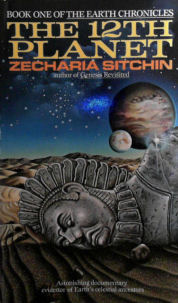
The clay tablets themselves as survived, capable of being translated, revealed much about these various cultures, as existed between about 3800 BC to 2000 BC. Indeed, the inscriptions upon the tablets documented not just mundane matters - that is the everyday affairs of the populace, including business and political matters or even religious beliefs; but also scientific knowledge, including astronomical knowledge.
Now the Sumerians themselves were quite adamant that they received their most profound knowledge from 'the gods'. And from a very detailed evaluation of the clay tablets, Sitchin was bold enough to state that this referred to extraterrestrial beings who came down to the Earth in some distant era, and essentially established the human race through genetic engineering; further aiding humanity as it expanded throughout the Earth, and helping to set up advanced civilisation on a global scale. In doing so these extraterrestrials transmitted some of their sophisticated knowledge to humanity.
Now the core focus of The 12th Planet is upon what Sitchin claims the Sumerians were told by the extraterrestrials about the architecture of the present solar system, most especially the existence of a 10th planet out beyond Pluto, a planet they called Nibiru.
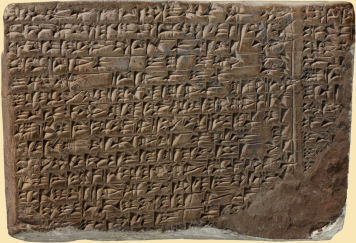
Now it is important to state here that the cuneiform tablets detailing the knowledge of the Sumerians are liable to interpretation. And in studying them, Sitchin presents his own. This is not to say that he stands alone however. For he does have supporters. One would thus do well to consider carefully his analysis.
Cylinder Seal VA243
In many lectures Sitchin has presented over the years concerning the existence of Nibiru - even right up until his death in 2010 - he oftentimes begins with a consideration of cylinder seal VA243, depicting what would appear to be the planets of our solar system arranged anti-clockwise in order about our Sun, between the heads of two of the main characters. Studied closely however, one cannot help but notice what would appear to be five bodies of significant size, as depicted. Now four of these, Sitchin suggests are the four known gas giants familiar to us:
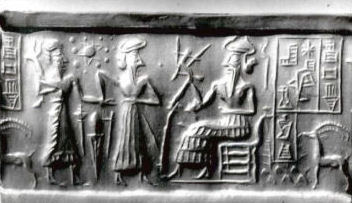
Jupiter, Saturn, Uranus and Neptune. But a fifth one though, appearing to be roughly the same size as Uranus or Neptune, Sitchin suggests is another great planet within our solar system - the one known to the Sumerians and Babylonians as Nibiru. Now from his analysis of the ancient cuneiform texts, Sitchin puts forward the view that Nibiru is in a highly eccentric orbit about our Sun, wherein the planet spends most of its time well out beyond Pluto. Its placement upon the Cylinder Seal somewhere between Mars and Jupiter though, is explained by Sitchin as being chosen to designate its perihelion or closest approach to the sun, which he indeed theorises to be somewhere halfway between Mars and Jupiter.
Now further to this, according to Sitchin, the planet Nibiru is one that was not an original member of the solar system when it was first formed, but one that came into our solar system after its original configuration was well established. It was the manner of entry of the body into the system, and ultimate capture by the sun, that established its orbit with a perihelion between Mars and Jupiter.
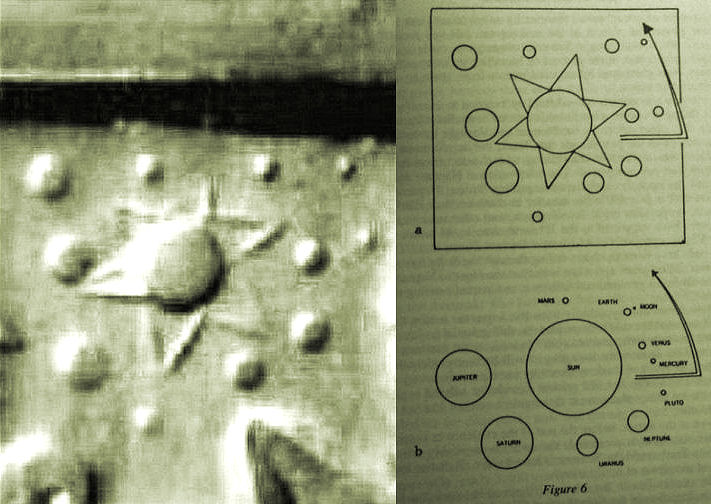
The essential astronomical narrative that Sitchin presents from his study of the Cuneiform tablets as to the early formation of the solar system, is in point of fact, based upon a 'mythological' description of various battles between powerful gods within the heavens. Sitchin actively interprets stories of the wars and intrigues between various gods, as referring to actual celestial events e.g. two gods clash in battle, means two planets physically crash into one another. etc. In brief, Sitchin's narrative, with accompanying diagrams as cited from his books (above).
Sitchin's Early Solar System & The Entry of Marduk
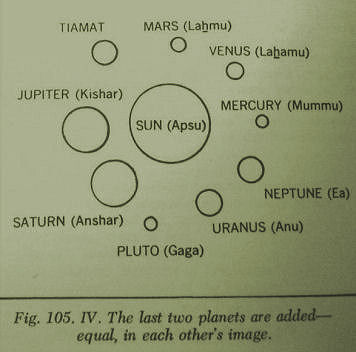
In the early stages of the solar system prior to the entry of Nibiru, and also the creation of the Earth, the planets about the Sun were in a slightly different arrangement to that of the present age. And certain notable features of our solar system as existent today, were not yet established. One example is the creation of the asteroid belt between Mars and Jupiter. Looking at one of Sitchin's diagrams - figure 105 - one can see nine bodies about the Sun. Their order in terms of extended distance from the central solar body begins with Mercury, going anticlockwise about the Sun.
Now a few key features must be noted. In the absence of the asteroid belt there is a planet present known as Tiamat. This occupies a position roughly halfway between Mars and Jupiter. One may also note that Pluto is not the furthest out from the Sun. Indeed, from his study of the cuneiform tablets, Sitchin believes that Pluto was originally a moon of Saturn.
Per his interpretation of the Sumerian mythologies, a new God enters the arena that is our solar system. The name of this new God is Marduk; a wandering planet if you will from deep space, that has what one might characterise as a chance encounter with our solar system. Upon its close approach, Marduk is affected by the gravitational influence of the Sun and the other planets, such that its trajectory is significantly altered, forcing it deep into the inner solar system.
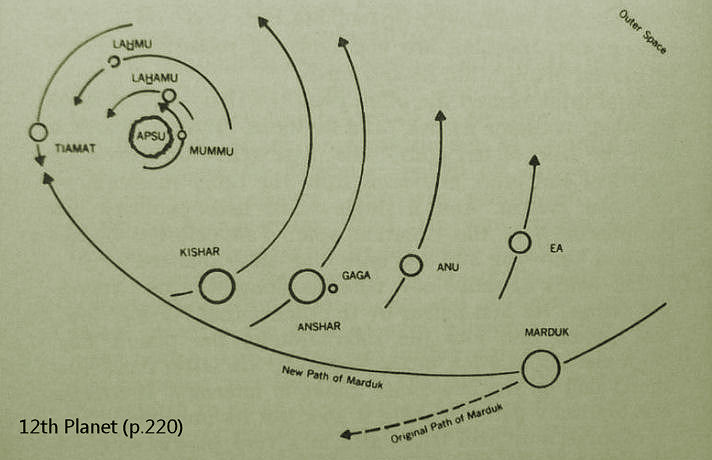
Coming in clockwise to all the other planets, it agitates each in turn as it passes. Moreover, its motion deep within the system puts it on a direct collision course with the planet Tiamat. An epic battle ensues between these gods, Marduk and Tiamat, with the latter itself aided by another minor God - its accompanying moon Kingu. As a result of the encounter, which involves a direct collision between Marduk and Tiamat, the latter celestial body is vanquished and cleaved into two, with debris strewn throughout the system.
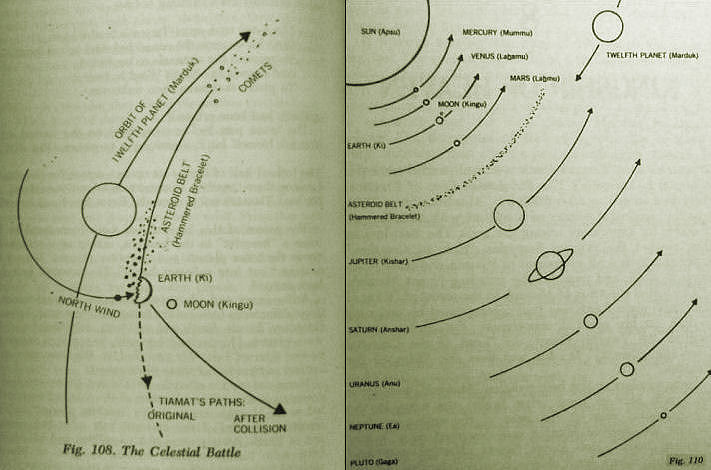
Now according to Sitchin's interpretation of the cuneiform tablets, a small portion of the debris from the encounter settles to become the debris field that we know today as the asteroid belt, the rest undoubtedly being drawn towards and accumulated by the other major bodies of the solar system, notably Jupiter.
In addition, a major surviving fragment of Tiamat - failing to disintegrate completely - is knocked from its orbit roughly halfway between Mars and Jupiter, to settle into an orbit much nearer to the Sun. Coalescing into a natural spherical form as time passes, this fragment eventually becomes the planet Earth. Moreover, the minor god, or celestial body noted previously, called Kingu, accompanies the surviving fragment, thus becoming our moon.
Now in addition to these noted changes, one final point should be added. Sitchin also states that the cosmic war resulted in Marduk, as it came into the solar system, gravitationally dislodging Pluto from Saturn, forcing it into its own orbit direct about the Sun, much further away. Thus did Pluto become a planet in its own right. And thus did the solar system as a whole, become established in its present configuration.
But what though of the fate of the intruder planet Marduk itself? Well, as a result of its collision with Tiamat, the planet became permanently captured in a highly eccentric orbit about the sun, taking up 'station Nibiru', per Sitchin's interpretation of the cuneiform tablets. The body is thus effectively renamed Nibiru, translated to mean 'planet of the crossing'. Essentially therefore one can see that Marduk and Nibiru are in fact the very same celestial body, but it is only after its encounter with our solar system, with its new orbit established, that the new name of Nibiru is assigned to it.
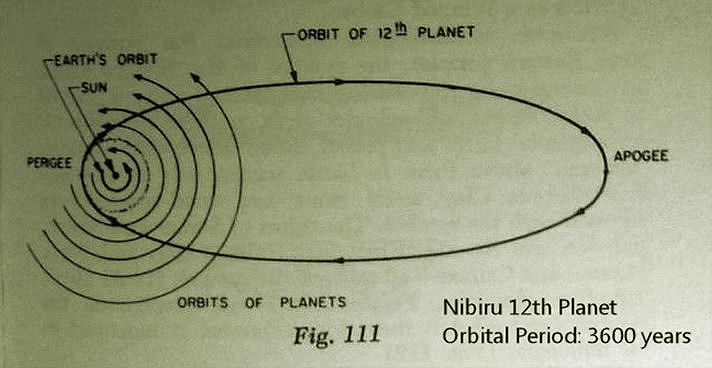
A 3600 Year Orbit
Now with this new addition to the solar system, one has to inquire as to its orbital period, and indeed, Sitchin is led in his studies to suggest that the time in question is 3600 years. This is not however based upon an explicit reference in the Sumerian writings as to the orbital period of Nibiru. Rather, Sitchin builds up to this conclusion after presenting a series of suggestive links. Essentially, the case for this value actually being the orbital period of Nibiru, is one that rests on circumstantial evidence.
Though Sitchin does hold to the view that it is strong circumstantial evidence. A citation from his book, The 12th Planet, summarises his conclusion, if you will:
...the Mesopotamian and biblical sources present strong evidence that the orbital period of the 12th planet is 3600 years. The number 3600 was written in Sumerian as a large circle. The epithet for the planet - shar ("supreme ruler") - also meant "a perfect circle," a "completed cycle." It also meant the number 3600. And the identity of the three terms-planet/orbit/3600-could not be a mere coincidence. (p.247-8).
Now one should definitely study Sitchin's writings in depth to most fully appreciate the intricate connections as led him to arrive at the very specific conclusion, that the orbital period of Nibiru is indeed some 3600 years; established due to its interaction with our solar system. Suffice it to say here though that this is Sitchin's conclusion, and it is his theories that are under evaluation here. Its truth is thus assumed; and with it, there is only one further point to note here to complete the astronomical narrative as developed by Sitchin: the date of first entry of Nibiru into the solar system, as led to the very formation of the earth itself if you will. This is given by Sitchin as some 4.5 billion years ago - the generally accepted date given by astrophysicists for what is the creation date of the earth, as we know it.
The reconfiguration of the solar system due then to an intruder body occurred very early on, following the initial formative stage of the other celestial bodies about the sun, in their original pattern. Following its entry though, Nibiru is said to have established itself in a highly elliptical orbit 3600 years in length about the sun, retaining a relatively stable pattern right up to the present day, essentially in harmony with all the other planets, as they stand in their own orbits.
Mass Values for Tiamat & Marduk/Nibiru
With Sitchin's astronomical narrative presented then detailing a series of celestial events that occurred long ago, based upon an interpretation of ancient Sumerian mythical stories, it would be well to consider if his solution is supported by modern science. Now in doing so, one might first consider the issue of both the size and the mass of Nibiru. As an incoming intruder body, just what are the assigned values in question? Well from his early research, as noted, Sitchin's focus on the cylinder seal VA 243, appears to have led him to initially conclude that the size of Nibiru is on par with a gas giant; most notably either Uranus or Neptune.
Now indeed, in looking at other diagrams that Sitchin has produced in his books, he also appears to regard the planet Tiamat, as was destroyed by Nibiru, to itself have been a significant sized body approximating a gas giant. That said however, Sitchin does seem to intimate that Nibiru was somewhat larger that Tiamat, most likely explaining why the latter body broke up on contact with Nibiru. There is however no real decisive answer as such, at least from examining his diagrams. One could say simply that Nibiru could be the size of Jupiter at a maximum, or possibly the size of either Uranus or Neptune as a minimum.
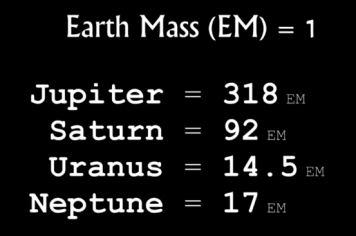
Now at this stage - the mid to late 1970s - when the 12th Planet was first published, the work of one particular astronomer might well be cited as giving some support to Sitchin's original solar system, with a high mass value for Nibiru - the intruder body. The individual in question is one Michael Ovenden. Working upon the problem of the asteroid belt during this time, Ovenden produced a series of dynamical equations to derive a value for what would have been the mass of the planet between Mars and Jupiter, prior to its destruction, as led to the creation of the asteroid belt. His equations led him to conclude that the original planet that must have occupied the space between Mars and Jupiter, would have had a mass value very close to that of Saturn.
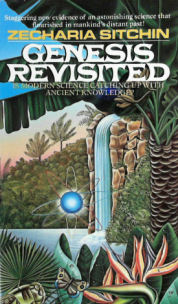
Now by way of comparison one can see the relative values of all of the known gas giants in terms of Earth mass units. If Tiamat thus possessed a high mass on par with Saturn, then this would support a still higher mass value for Nibiru, the incoming planet that collided with Tiamat. The work of Ovenden here does appear then to offer some support to Sitchin.
That being said however, as Sitchin's work progressed into the 1980s and 90s, it would seem that he completely revised his position on the mass of both Tiamat and Nibiru. Indeed, by the time of the publication of his book "Genesis Revisited" in 1990, Sitchin had totally discarded the notion that either of the celestial bodies were on par with the size of a gas giant. Instead, the favoured mass values for both bodies were now thought to be only on the order of some small multiple of the mass of the Earth. In effect then, he appears to have downgraded the significance of the cylinder seal VA 243 somewhat.
Though still holding to the view that the diagram in question does depict the current solar system, Sitchin appears to have dropped the notion that the noted additional planet, top left, is depicted in terms of its real proportional size relative to the other bodies. Now this change of view seems to have come in large part from consultation with various astronomers regarding the latest discoveries pertaining to the search for Planet X - what Sitchin himself holds to be the Sumerian Nibiru.
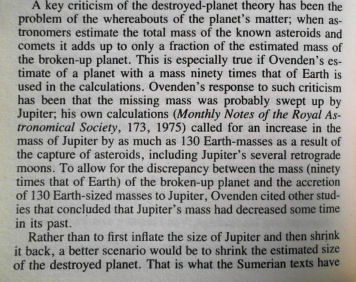
With this noted then, in his book "Genesis Revisited," Sitchin is highly critical of the work of Ovenden, which he does indeed appear to be intimately familiar with. For Sitchin strongly argues against Overden's work suggesting that the original planet between Mars and Jupiter was on par with the mass of Saturn. And this, on the basis that there is a certain mass discrepancy in Ovenden's calculations. One can see the noted passage detailing Sitchin's criticism of Ovenden, as cited from Genesis Revisited (left). Indeed, in this section of his book Sitchin further clarifies the situation with regard to Nibiru encountering Tiamat. The latter body, Sitchin notes, is referred to as "the cleaved body," suggestive of it being smashed into two roughly equal pieces, one of which Sitchin believes became the Earth. To quote, "If Earth is the remaining half of Tiamat, then Tiamat was roughly twice the size of the Earth, not 90 times."
Now with this point noted, Sitchin's further research, in consultation with astronomers, led him ultimately to conclude that the mass of Nibiru was some measure greater than two Earth masses, though not extremely so - certainly not anywhere near the size of any of the four known gas giants in our solar system.
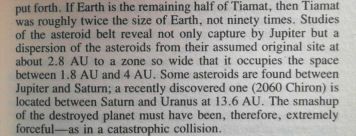
Indeed, one may cite in particular a most notable meeting between Sitchin and Dr. Robert Harrington of the United States Naval Observatory; conducted as part of a television documentary, wherein Sitchin presented to Harrington some of his theories concerning the early formation of the solar system, and Planet X, or Nibiru, as Sitchin refers to the celestial body in question.
Zecharia Sitchin & Dr. Robert Harrington (US Naval Observatory)
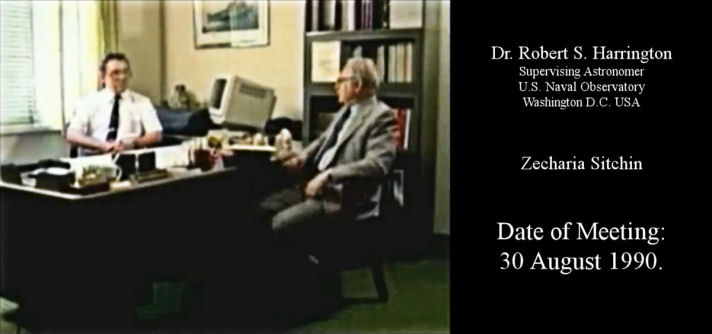
Now Harrington himself is credited with writing an important research paper upon the issue of the existence of Planet X. And this based upon observed anomalies in the orbits of Uranus and Neptune, as noted at the beginning of this presentation. The paper in question is dated 1988, and from his analysis Harrington is able to propose a theoretical orbit for Planet X about our Sun, presenting a list of its key orbital elements and its probable location, somewhere in the region of Scorpius.
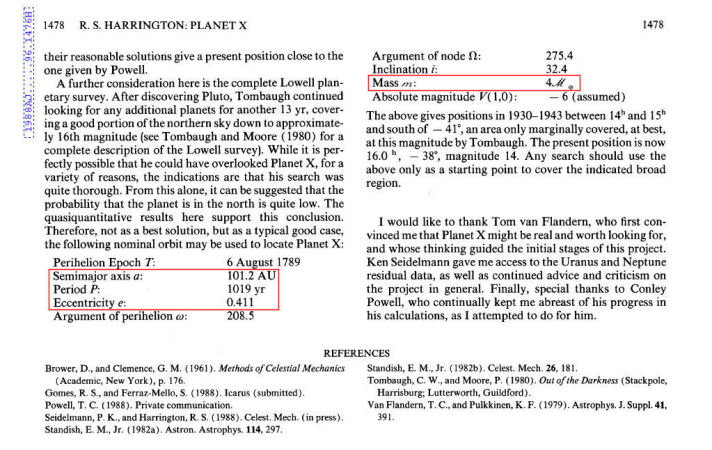
Of the values as given, one may note first of all the estimated mass of Planet X, at some 4 Earth masses, which indeed Harrington derives from the detected perturbations of Uranus and Neptune. Moreover, this very value, Sitchin himself appears to directly adopt as the mass value for Nibiru, no doubt due to his conversations with Harrington. And this is evidenced from his book Genesis Revisited, wherein Sitchin actually references the very research paper by Harrington as is here being discussed. In the context of his belief that the original mass of Tiamat was some 2 Earth masses, Sitchin suggests that the mass of Nibiru, as crashed into it, must be fractionally greater than Tiamat; being itself on par with some low multiple of the mass of the earth.
Essentially, Sitchin appears to throw his lot in entirely with Harrington's mass estimate for Planet X, claiming that this must be the mass of Nibiru, under his own system. That said however, it is important to note that all of the other key orbital elements proposed by Harrington, are roundly rejected by Sitchin. The most obvious of course is the proposed orbital period of Planet X. Harrington's value of 1019 years is markedly different from Sitchin's proposed value of 3600 years. Indeed, the very orbit itself as described by Harrington in no way conforms to that of Sitchin, as would lead to a deep penetration of Planet X into the inner solar system.
In this regard one may consider the value for the semi-major axis or mean distance from the sun of Planet X, given by Harrington as 101.2 AU. Now with one astronomical unit itself being the mean distance between the earth and the sun, at some 93 million miles, one can see then that Planet X is estimated by Harrington to be about 100 times further out from the sun than the earth itself, on average. Now this last point is critical, as indeed Harrington gives an eccentricity value for his proposed Planet X, of 0.411. Now were in fact the value here to be exactly zero, it would describe a perfectly circular orbit. And thus a value of 0.411 gives an orbit that is a significant deviation from a precise circle.
But what does this say though about just how close the object gets to the sun: its perihelion? Well, based upon a semi-major axis of 101.2 AU, and an eccentricity of 0.411, such a body orbiting the sun, would attain its closest approach at some 60 AU. The object would never get closer than this to our central star. And indeed, as Pluto itself has an orbital distance of some 40 AU, Harrington's Planet X is one that has never, and will never, enter deep into our solar system. Now for Sitchin's Planet X i.e. Nibiru, with an orbital period of 3600 years and a perihelion on par with the asteroid belt at some 2.7 AU, the orbital eccentricity is over 0.99.
It can be seen then that after consultation with Harrington, Sitchin is willing to adopt Harrington's mass value for Planet X, as being that of Nibiru. However, all the other orbital elements as proposed by Harrington are rejected by Sitchin in favour of his own orbit, as based upon his interpretation of the Sumerian texts.
Further Research Papers on Planet X
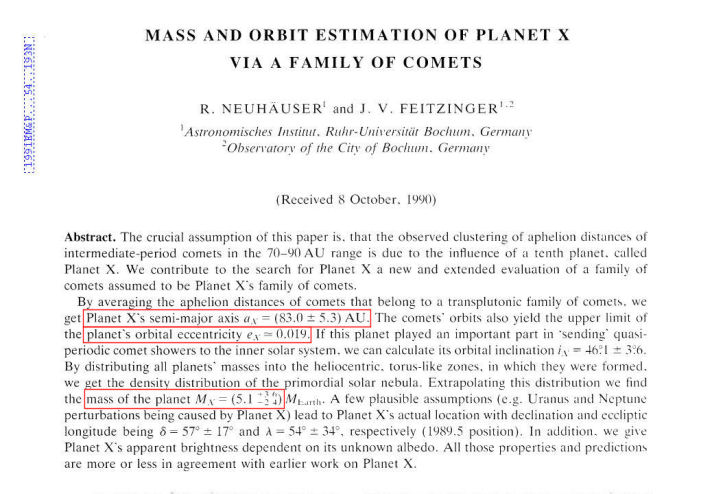
Now in light of this, one may of course consider if other astronomers have also produced research papers providing solutions for Planet X, that may indeed perhaps favour an even more extreme orbit, as would support Sitchin. Or, whether they favour an orbit similar to Harrington's. In doing so, one has to concede that such support is directed towards the work of Harrington, and not Sitchin.
Indeed, one such research paper published in 1990 by Neuhauser and Feitzinger, some two years after Harrington's own, provides an orbital solution for Planet X as being even more circular. In this instance, the researchers evaluate the orbital patterns of comets to arrive at a solution.
From the key values as highlighted, one can see that the mean distance from the Sun as proposed for Planet X is some 83 AU. Now this is of course significantly less than Harrington's at 101.2 AU. That said however, the eccentricity of Harrington's proposed orbit at 0.411 gave his body a closest approach of some 60 AU.
In contrast, the paper of Neuhauser and Feitzinger assigns an eccentricity to Planet X very close to zero, at 0.019. As a result of this, it does not get closer than even 80 AU to the Sun, at any point in its orbit. Moreover, in maintaining such an orbit about the Sun, the mass solution for the object is slightly greater than that of Harrington, though indeed subject to quite a margin of error. Here Neuhauser and Feitzinger propose a mass solution of 5.1 Earth masses.
One can clearly see then that other researchers and not just Harrington, are of the mind that the best solutions for Planet X do not result in an object penetrating deep into the inner solar system. That noted however, the papers by Harrington, Neuhauser and Feitzinger, are well over 20 years old as of the present time, and much has changed within the field. It would be well therefore to consider some of the more recent research in this area of study, in light of new discoveries.
In doing so, it would of course be well to note one of the most important developments to have occurred within astronomy over the past two decades. That being the discovery of a whole host of new minor planets further out beyond Pluto. Indeed, as a result of this, Pluto was demoted to the category of minor planet itself in 2006, prior to which it was considered to be a full major planet so to speak; its status being equal to that of the others.
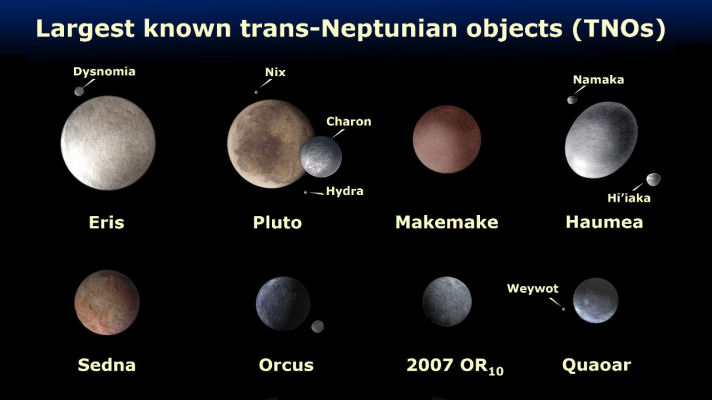
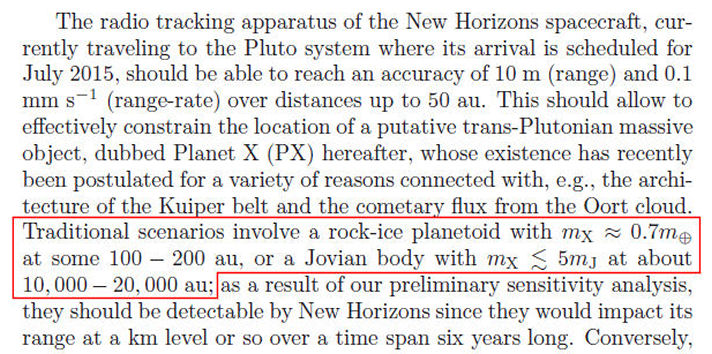
The discovery of these new bodies has of course led to a deeper consideration of Planet X as a significant sized object in the outer reaches of our solar system. And one may cite a very recent paper from January 2013, whose introduction notes that the latest scenarios for Planet X - as a body quite close to our solar system, posit mass values significantly less than the previous work of Harrington, Neuhauser and Feitzinger. Here one can see the critical statement, that the work to date favours a mass value of 0.7 Earth masses, for Planet X existing between a range of 100 and 200 AU from the sun. Now one may recall the paper by Harrington in particular, that proposed an average distance for Planet X of 100 AU, combined with a mass value of four Earth masses. Here then the latest summary of the research pertaining to Planet X, offers a mass value of 0.7 Earth masses - and this, beginning at 100 AU. Now in addition, one may indeed note also that there is a proposed solution for Planet X being a celestial body some 10 to 20,000 AU distant from the Sun, on par with the mass of several Jupiter masses. Now such a solution here is based upon work looking at climate and the geophysical record of the Earth over extreme lengths of time, and tying in abrupt earth changes to the influence of a celestial body, itself with an extreme orbital period.
In the literature to date, one finds therefore proposals which involve Planet X either being somewhat very close to the known planets of our solar system, or being at rather an extreme distance. There are arguments for both cases. In noting this though, there is yet a further discovery within astronomy that strengthens the case for Planet X as being very close to the known major bodies of our solar system, closer even than the early proposals of Harrington, Neuhauser and Feitzinger.
Indeed, it is important to realise that when these scientists produced their papers and developed their solutions for Planet X, they were completely unaware of the existence of a second asteroid belt within our solar system, just out beyond Neptune. Discovered in 1992, and commonly referred to today as the Kuiper belt, the existence of this additional asteroid field came to light some two years after the paper published by Neuhauser and Feitzinger, and four years after the paper published by Harrington.
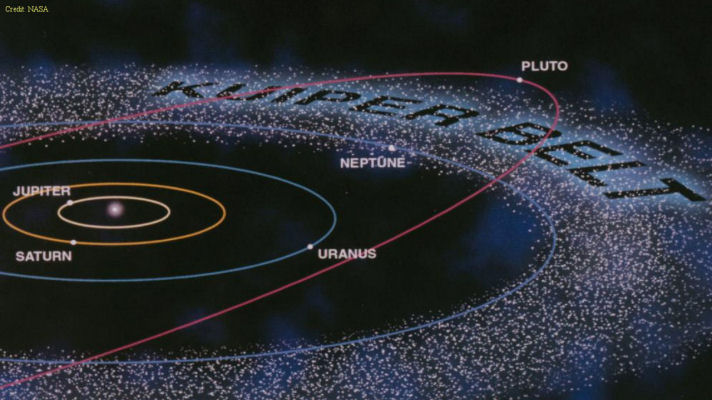
Now the Kuiper belt itself is an asteroid belt similar in many ways to that which exists between Mars and Jupiter, although the scale of the field is far greater. Beginning at some 30 AU from the Sun, at about the same distance as Neptune, the field extends to approximately 50 AU, being in estimate some 20 to 200 times more massive than the inner asteroid belt. Now in terms of population, it is believed that there are some 100,000 Kuiper Belt Objects within the field over some 60 miles in diameter. Indeed, one may consider that the now designated dwarf planet Pluto is one of the largest objects within the Kuiper belt.
That said however, the vast bulk of the small objects as make up the field are composed largely of frozen volatiles (termed "ices"), such as methane, ammonia and water; differing quite markedly from most regular asteroids, which themselves are composed primarily of rock and metal. With respect then to this newly discovered outer asteroid belt, certain astronomers have been able to conduct studies of some of the more prominent objects within the field, revealing perturbations that are once more suggestive of a significant sized body, existing somewhere beyond the outer edge of the field itself. In this one may cite Rodney Gomez, an astronomer at the National Observatory of Brazil in Rio de Janeiro.
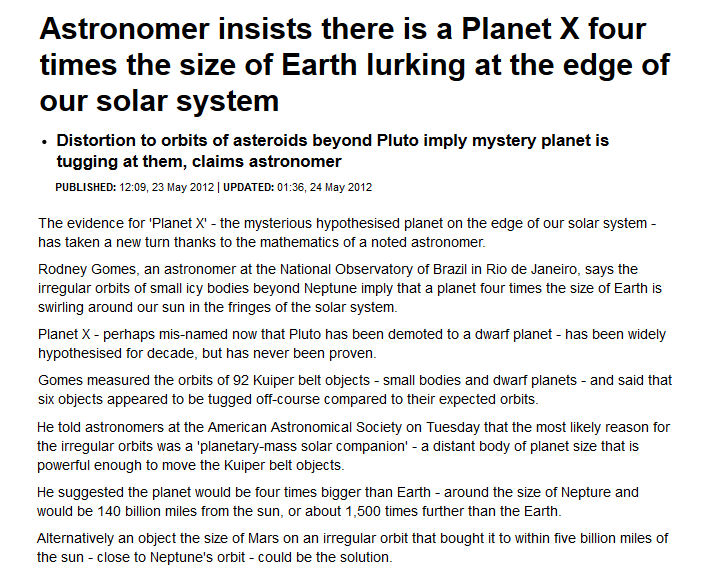
In an evaluation of 92 Kuiper Belt objects Gomez found that six of them appeared to be tugged out of their regular orbits, and suggested that this was due to another object of some significant size disrupting them. And one can see in the paper, two solutions given. One is for a Neptune sized object at some 1500 astronomical units distant from the Sun.
And another is for an object the size of Mars, with a close approach at some 5 billion miles to our central star. Now indeed, one may note here that the mass of the planet Mars is equivalent to about 1/10th of the mass of the Earth, or 0.1 Earth masses. And also, that the cited distance of 5 billion miles is equivalent to some 54 astronomical units. Now the close approach solution hereby given is most intriguing, when one considers the very of presence of the Kuiper Belt. For as already noted, the outer edge of the belt cuts off at some 50 astronomical units.
Indeed, one researcher, Patryk Lykawka of Kobe University, has claimed that the gravitational attraction of an unseen large planetary object, perhaps the size of Earth, or Mars, might be responsible for the sudden cut off of the Kuiper Belt. Essentially therefore, what is proposed is that a celestial body orbiting close to the Kuiper belt has been actively responsible for sculpting the outer edge. Perhaps even actively maintaining it. In consequence, the very orbit of such a body would closely conform to the outer edge of the field, and thus not possess an eccentricity that would take it deep within the inner solar system.
Conclusion
In light of all the work presented thus far detailing the scientific research concerning the existence of Planet X, it would be fair to say then that the findings of the astronomical community stand very much against the work of Zecharia Sitchin. As far as the astronomical data suggests, the solutions that posit a Planet X close to the outer boundary of our solar system, just beyond the Kuiper Belt, invariably involve a body whose orbit does not allow for a deep penetration into the inner solar system. Rather, all of the solutions generated tend to favour an orbit close to circular, or only slightly eccentric - not radically eccentric.
Bearing in mind then the critical point that Sitchin does equate the Sumerian Nibiru with the Planet X modern astronomers are actively searching for, one has to conclude that Sitchin's proposed body with an orbit of 3600 years and a perihelion on par with the asteroid belt, at 2.7 AU, is falsified.
Quite simply, Zecharia Sitchin's Nibiru, does not exist...